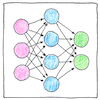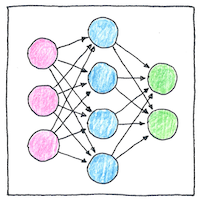Warren Sturgis McCulloch,
Walter Pitts
computer science

|
Neural networks
Warren Sturgis McCulloch and Walter Pitts realized that the computational power of biological neural networks could be modeled using a non-biological or logical mechanism. The McCulloch-Pitts neuron is a mathematical model of a biological neuron, which weighs and sums its inputs and produces an output if its threshold has been reached.
Neural processing
The idea is to connect McCulloch-Pitts neurons in a network, called an artificial neural network. Then you feed its various inputs with sample data and train the network by adjusting the weighting factors until you get the desired outputs. This model led to theories of automata, cybernetics, cognitive modeling, and artificial intelligence.
Natural intelligence
One definition of intelligence is mental processing that a computer can not copy, so that “artificial intelligence” is an oxymoron. If we were to commit to that definition, many people would not qualify, because they decide nothing that a computer couldn’t. Yet we think that computers cannot have intuition, cannot make leaps of thought to discover things, and cannot be sane or insane. Whether informed by patterns of neuroses or pheromones, we feel that only machines cannot suffer, and that any animal that survives is intelligent or lucky.



McCulloch, a neurophysiologist, collaborated with Pitts, a logician who was homeless, having invited Pitts to live with his family. They called their model threshold logic. Each McCulloch-Pitts neuron must receive a sum of inputs over a threshold value before it emits its output, just as a biological neuron.
See also in The book of science:
Readings in wikipedia: